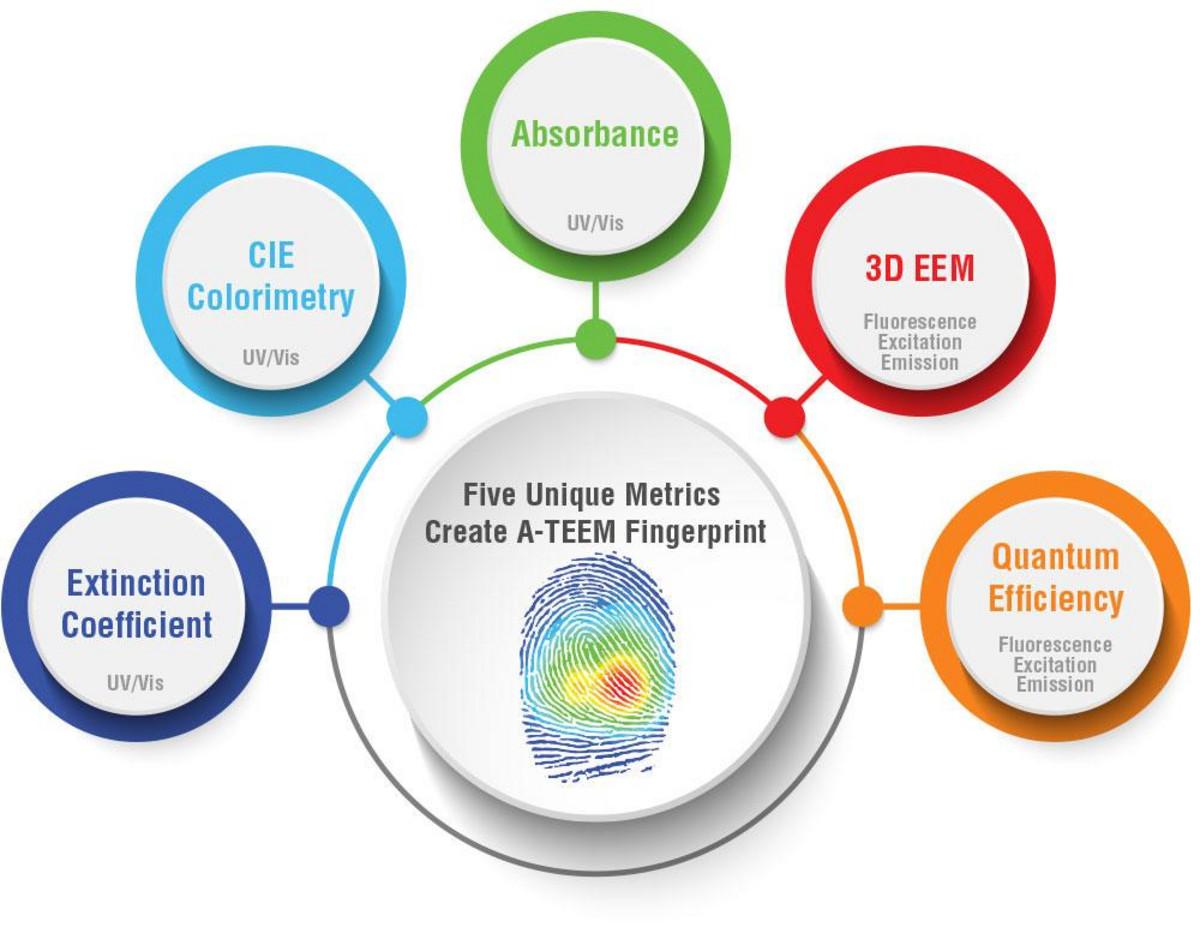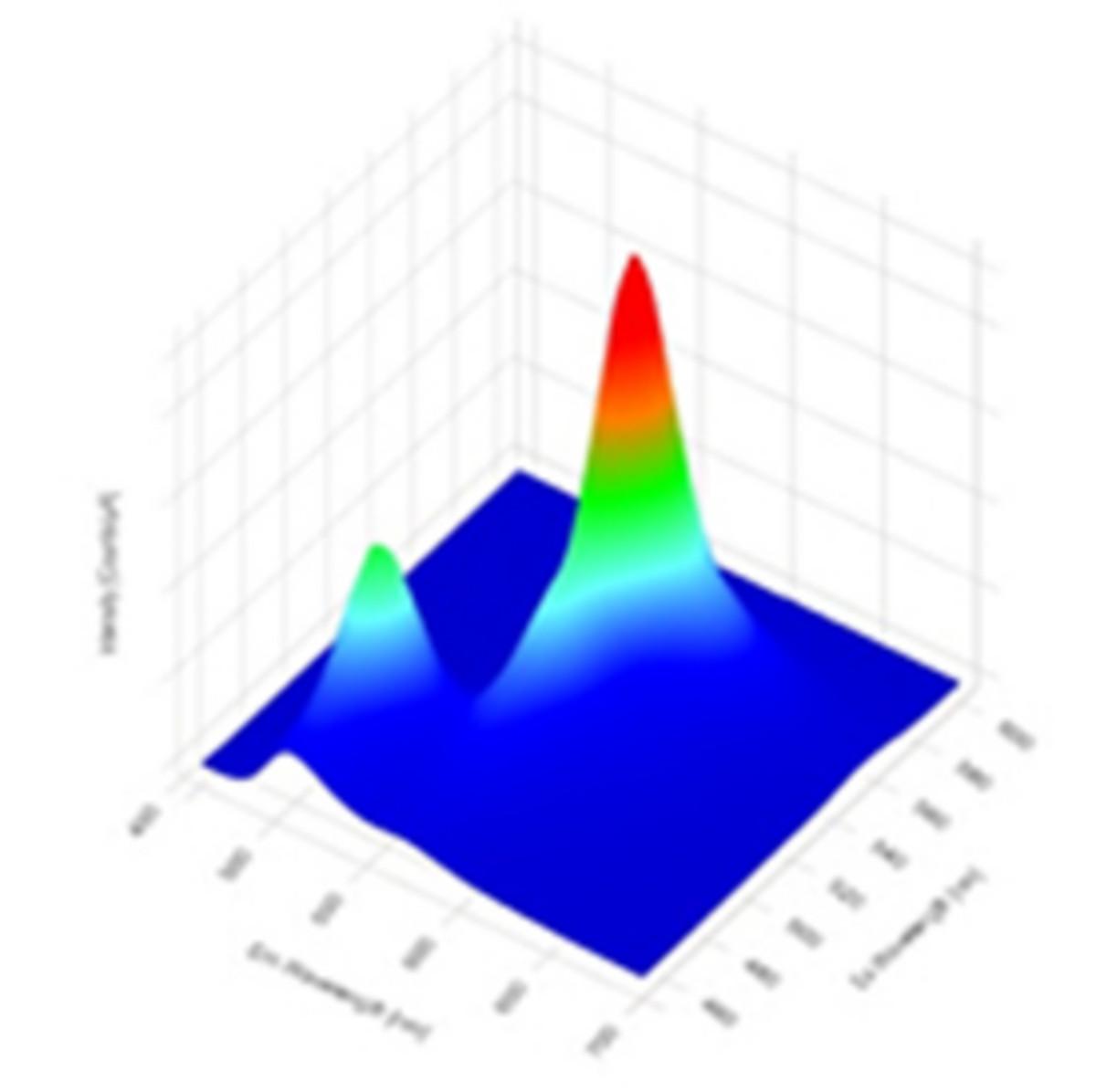

A-TEEM™ stands for simultaneous Absorbance, Transmittance, and Fluorescence Excitation-Emission-Matrix (EEMs) Acquisition. It is a novel, robust, and extremely sensitive analytical technique. A-TEEM features the best attributes of molecular spectroscopy (speed, low cost per measurement, and lab-to-line placement), and chromatography (sensitivity, selectivity, low limits of detection and quantification).
HORIBA’s new A-TEEM Compliance Package provides solutions for record-keeping, method validation, and instrument verification to meet regulatory requirements.
The name itself reflects the two techniques that are combined for this 2-in-1 method:
A-TEEM Features:
A-TEEM is a green technique that promotes sustainability compared to most separations-based approaches. Yet, A-TEEM rivals chromatography in the quantification of complex matrices. Due to its speed and low per-measurement costs, it has replaced standard separations methods for routine measurements in food and pharma.
UV/Vis absorbance data collected simultaneously with EEMs corrects for the IFE, resulting in A-TEEM profiles that are independent of concentration, and provide linearity over a broader concentration range (typically up to ~2 absorbance units). These A-TEEM molecular fingerprints are concentration-independent, unlike EEMs collected from traditional scanning fluorometers, and open the door to routine quantitative analysis with A-TEEM, as has been demonstrated in food and pharma.
HORIBA’s proprietary A-TEEM technology enables the simultaneous acquisition of three modalities: fluorescence EEMs, absorbance measurements for multi-component analysis, and transmission measurements for CIE colorimetry.
Simultaneous Acquisition 3 modalities – Cranberry Extract
These three modalities result in the determination of five individual characteristics that together create the unique, highly selective, and concentration-independent A-TEEM fingerprint that can be used for screening and classification.
A-TEEM contours capture subtle variations in the molecular structure of highly similar compounds, resulting in unique concentration-independent molecular fingerprints that can be used to identify and quantify sample components. Cresol isomers are rapidly resolved with A-TEEM, coupled with multivariate analysis, which were acquired in seconds.
A-TEEM has an extensive and successful analytical history in environmental water research, with many applications, including measuring colored dissolved organic matter (CDOM), Oil-in-water analysis, and including an American Society for Testing and Materials (ASTM) method for benzene, toluene, ethylbenzene and xylene (BTEX).
A-TEEM is particularly well suited to the identification and quantification of complex biomolecules. Aromatic amino acids are easily distinguished by unique A-TEEM fingerprints and are highly responsive to the local environment. Therefore A-TEEM can be used for the characterization and quantification of proteins that contain tyrosine, tryptophan, and phenylalanine. Subtle changes in secondary structure or interaction with DNA, for example, are reflected in shifts in the A-TEEM molecular fingerprint. Unlike other spectroscopic techniques such as Raman, NIR, or FT-IR, A-TEEM is insensitive to water and simple sugars, making it able to tackle very low-concentration formulations like many vaccines.
A-TEEM has been used to differentiate multi-component vaccines, classify vaccine compounds based on amino-acid substitution, post-translational modification, and aggregation state. In addition to providing a quantitative model of AAV empty-full ratio, A-TEEM was also able to distinguish between AAV Serotypes. Additionally, Exosomes from different cancer cells have also been differentiated using A-TEEM.
A-TEEM has been used to determine the quality of basal and feed media, to monitor bioprocesses, and for reaction monitoring.
A-TEEM is ideally suited to the quantitative and qualitative analysis of components in complex matrices. Molecules that matter to biopharma and natural products (proteins, co-enzymes, terpenes, vitamins, by-products of bacterial contamination, etc.) can be identified and quantified, and molecules like water and simple sugars that do not have native fluorescence do not contribute signal.
A-TEEM is also sensitive to metabolites (NADH, NAD(P)H), vitamins, colored components, hydrolysates, aggregation, and mycotoxins.
Many of these samples are challenging for chromatography and vibrational spectroscopy, yet can be performed with A-TEEM with minimal sample preparation, low use of solvents and other consumables.
A-TEEM has been used to perform quantitative analysis on many different analytes of interest, tracking components in wine to replace 10-hour quality profiles with a 1-minute measurement, as a measure of freshness for oil products, detecting mold in grains, and to detect evidence of economic adulteration in multiple natural products.
Compared to the conventional chromatographic methods, A-TEEM has the capacity to significantly reduce measurement times with minimal sample preparation. A-TEEM overcomes many of the pain-points associated with Chromatography (HPLC, LC-MS, GC, GC-MS):
A-TEEM benefits over chromatography
A-TEEM shares the following strengths with chromatography:
Compared to vibrational spectroscopy, A-TEEM is extremely sensitive and specific, with the capacity to perform quantitative and qualitative measurements on samples in the ppb range, orders of magnitude lower than is typical with vibrational spectroscopy. A-TEEM overcomes many of the pain-points associated with vibrational spectroscopy (Raman, FT-IR, NIR):
A-TEEM benefits over vibrational spectroscopy
A-TEEM shares strengths that make vibrational spectroscopy the dominant analytical sensors for process analytics:
Compared to a traditional EEM, the A-TEEM technique provides better molecular specificity, and is therefore better suited to chemometric analysis for both quantitative and qualitative analytical applications. A-TEEM overcomes the main limitations of a traditional EEM:
Traditional scanning spectrofluorometers collect 3D Fluorescence in the form of excitation emission matrices, or EEMs, a contour of fluorescence intensity as a function of both excitation wavelength and emission wavelength. Many published scientific papers cite the use of scanning spectrofluorometers for fluorescence EEM component analysis in food, water, and pharma.
There are fundamental limitations of traditional scanning PMT fluorometers:
HORIBA’s A-TEEM method overcomes these three limitations. Using CCD detectors, an entire fluorescence EEM can be acquired in seconds, solving the problem of slow measurement speeds. To solve the issue of quantitative modeling, simultaneously detected absorbance spectra are used to correct for IFE, resulting in concentration-independent A-TEEM molecular fingerprints for LoQs in the ppb range. This absorbance and transmission data can also be used for sample characterization, enabling non-fluorescing compounds to be characterized.
Figure 1. Three-dimensional contour plot viewed at an angle of a fluorescence EEM, with a three-dimensional axis for fluorescence excitation, emission and intensity.
Figure 2. Contour plot (top down view) of fluorescence EEM of fluorescein acquired in one second with the A-TEEM-equipped Duetta.
Aqualog A-TEEM chemometrics analysis presented here are derived from Eigenvector Research Incorporated, Solo software.

Aqualog A-TEEM Autosampler Accessory
A-TEEM Spectroscopy
Fluorescence and Absorbance Spectrometer
Automated Organic Analysis & Early Warning Sentinel
The Gold Standard for Water CDOM Research
Você tem alguma dúvida ou solicitação? Utilize este formulário para entrar em contato com nossos especialistas.








